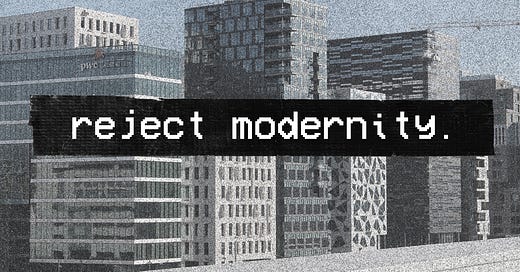‘Reject modernity, embrace tradition’ is a provocative slogan that has been co-opted by various online groups in pursuit of differing agendas. Nevertheless, aversion to modern trends, aesthetics, and technology has intensified. A glance at nearly any sector of society—architecture, entertainment, literature, furniture—reveals the underlying cause: the unmistakable drift toward homogeneous, soulless design. Urban areas are all gradually shifting towards an identical look: boxy, upscale apartment buildings, soaring skyscrapers, trendy restaurants, and Instagram-ready cafes. Is this merely a reflection of evolving aesthetics and alignment with the zeitgeist? Or is it the inevitable outcome of a profit-driven society shaped by capitalism and competition?
Aesthetics are Regressing
It’s fair to question the romanticizing of past aesthetics and ideals. A ‘57 Chevy surely doesn’t run as efficiently, smoothly, and safely as a 2025 Toyota RAV4. But must we sacrifice all beauty and human expression in the pursuit of high profits and low risk? There appears to be a silent cost looming on the periphery of these function-focused, soulless designs. When artistry is carelessly stripped from various sectors of daily life, a price is inevitably paid.
Contemporary architectural designs exemplify one of the most glaring shifts. From train stations to schools to corporate buildings, each has morphed into a dystopian, duotone, compact construction. If this were purely about structural integrity, historic buildings would be falling apart. Instead, profit, risk aversion, and marketability drive architects toward these apathetic, lifeless creations. The incentive to construct lasting, awe-inspiring buildings worthy of reverence no longer exists. Our society is fundamentally centered around profit and turnover rates. That means low-risk, efficient builds designed to serve a function—not to evoke emotion. And it goes far beyond subjectivity and aesthetics. Studies have shown how architecture can negatively impact mental health or even cause migraines. An article from The Conversation examined the ways in which deviations from nature and exposure to repetitive patterns can damage our health. The last thing you need to stare at for nine hours a day is more mind-numbing straight lines, while your desolate expression reflects off the glossy floor tiles.
Even Fast food establishments such as McDonald’s, Wendy’s, Arby’s, and others have adopted the dull, geometric aesthetic reminiscent of the Eastern Bloc. These producers of greasy, highly-processed food attempt to pass themselves off as modern restaurants by packaging their brand into quadrangular, drab structures. The reason for this can’t be as simple as cost-efficiency. I suspect it’s more about riding cultural shifts towards what’s ostensibly recognized as high-end or futuristic.
We also see homogeneity in the book industry, starting with covers, let alone plots. Thousands of new romance novels each year feature the same cookie-cutter cartoon characters, bright pastel colors, and oversized titles. Other genres, such as fantasy and sci-fi, share a similar issue. Publishers know what sells. Their extensive marketing teams track trends, understand the psychology of consumer decision-making, and favor tried-and-true designs.
Let us not forget about American suburbia. My own house is an identical copy of the other 30 homes in my subdivision, and our homeowners association ensures it stays that way. New construction communities are cropping up all across the country, showcasing the same materials, the same finishes, and the same floor plans. A glance out of an airplane window sends a shiver down your spine as you see millions of Americans packed into neat, homogeneous neighborhoods like ants.
What’s Wrong With Modernity?
Bare-bones housing, depressive designs, and copycat aesthetics are just the beginning. In the wake of rapidly advancing AI technology, culture will become even more bottlenecked. Songs will follow trends, fast fashion will accelerate, and books will prioritize sales over self-expression. Businesses will offer look, sound, and operate the same. Each unique aspect we appreciate in society will continue to contract into the most efficient, simplistic, and profitable version. We’ve already seen major corporations take this step with their brand image.
Modernity, in many ways, reflects a world stripped of expression and creative spirit. Intricate carvings in cathedrals, forged ironwork, and bespoke furniture have become a thing of the past. They have been relegated to museums and historical landmarks. Society rarely creates with joy, beauty, and craftsmanship. Our homes are filled with mass-produced, minimalist furnishings. We work in dispirited, muted buildings. We favor functionality over artistry. We live in a nihilistic culture that strives for immediacy and pleasure. That it why so many feel an intrinsic urge to reject the changes taking shape around them.
It is a mistaken assumption that progression always equates to progress. The future does not necessarily lead to more prosperous realities or greater self-expression. The onus is on society to discern when to reject modernity and embrace tradition.








